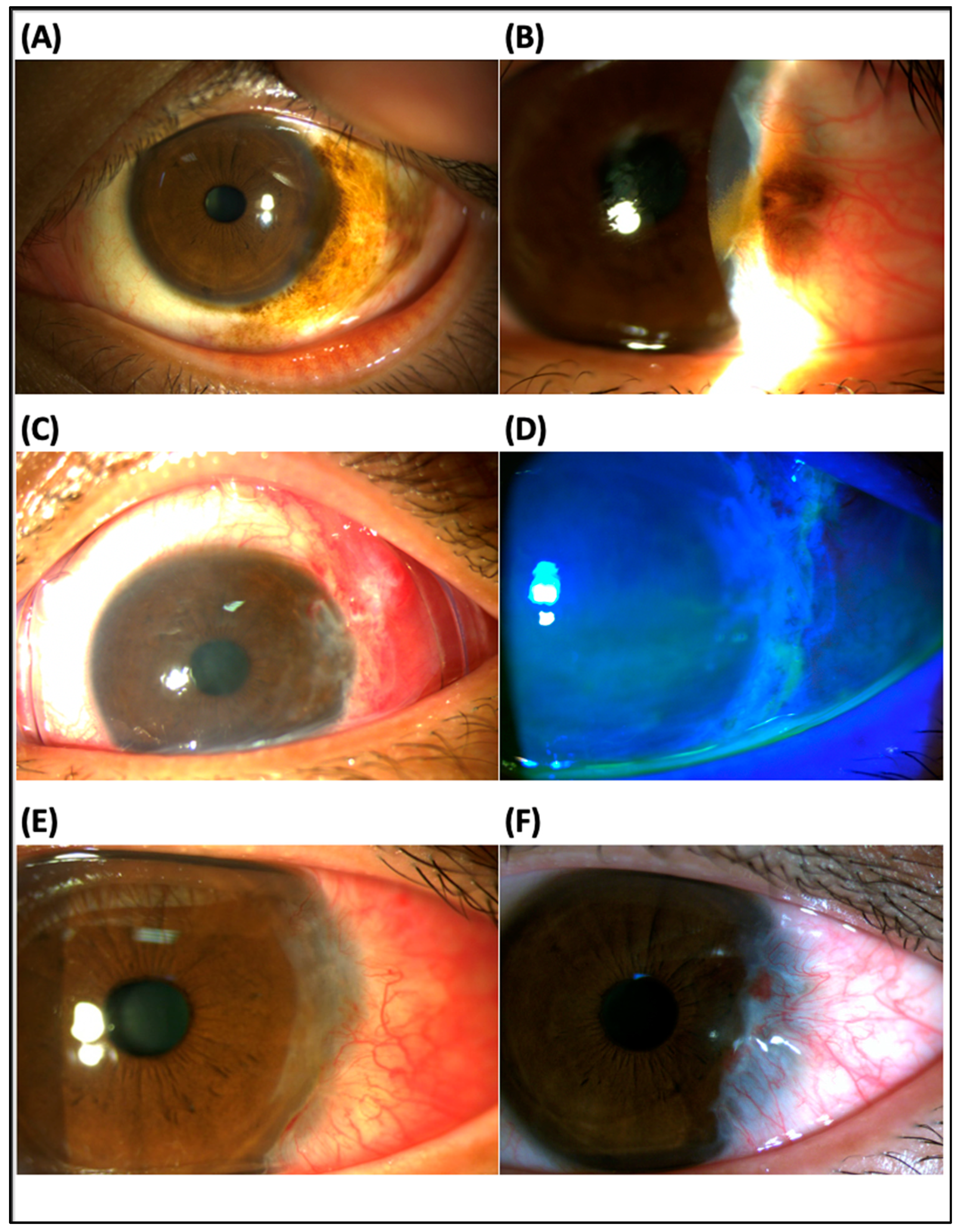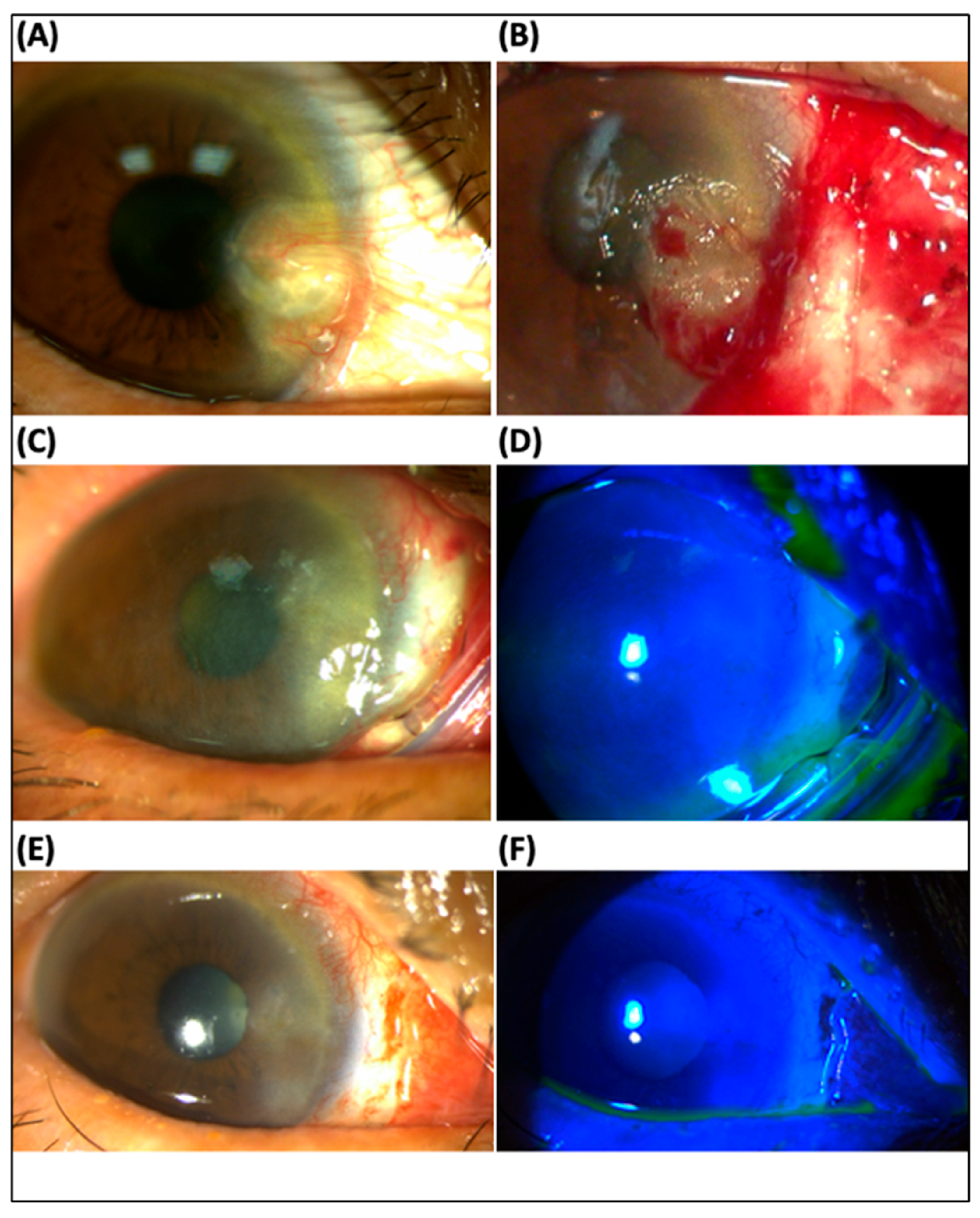Self-Retained, Sutureless Amniotic Membrane Transplantation for the Management of Ocular Surface Diseases
Abstract
1. Introduction
2. Methods
Amniotic Membrane Transplantation
3. Results
3.1. Recurrent Pigmented Conjunctival Tumors
3.2. Pterygium
3.3. Stevens–Johnson Syndrome
4. Discussion
Author Contributions
Funding
Institutional Review Board Statement
Informed Consent Statement
Data Availability Statement
Conflicts of Interest
References
- de Rotth, A. Plastic Repair of Conjunctival Defects with Fetal Membranes. Arch. Ophthalmol. 1940, 23, 522–525. [Google Scholar] [CrossRef]
- Lacorzana, J.; Campos, A.; Brocal-Sánchez, M.; Marín-Nieto, J.; Durán-Carrasco, O.; Fernández-Núñez, E.C.; López-Jiménez, A.; González-Gutiérrez, J.L.; Petsoglou, C.; Serrano, J.L.G. Visual Acuity and Number of Amniotic Membrane Layers as Indicators of Efficacy in Amniotic Membrane Transplantation for Corneal Ulcers: A Multicenter Study. J. Clin. Med. 2021, 10, 3234. [Google Scholar] [CrossRef]
- Meller, D.; Pauklin, M.; Thomasen, H.; Westekemper, H.; Steuhl, K.P. Amniotic membrane transplantation in the human eye. Dtsch. Arztebl. Int. 2011, 108, 243–248. [Google Scholar] [CrossRef] [PubMed]
- Koizumi, N.J.; Inatomi, T.J.; Sotozono, C.J.; Fullwood, N.J.; Quantock, A.J.; Kinoshita, S. Growth factor mRNA and protein in preserved human amniotic membrane. Curr. Eye Res. 2000, 20, 173–177. [Google Scholar] [CrossRef]
- Solomon, A.; Rosenblatt, M.; Monroy, D.; Ji, Z.; Pflugfelder, S.C.; Tseng, S.C. Suppression of interleukin 1alpha and interleukin 1beta in human limbal epithelial cells cultured on the amniotic membrane stromal matrix. Br. J. Ophthalmol. 2001, 85, 444–449. [Google Scholar] [CrossRef] [PubMed]
- Tseng, S.C.G.; Li, D.-Q.; Ma, X. Suppression of transforming growth factor-beta isoforms, TGF-? receptor type II, and myofibroblast differentiation in cultured human corneal and limbal fibroblasts by amniotic membrane matrix. J. Cell. Physiol. 1999, 179, 325–335. [Google Scholar] [CrossRef]
- Kruse, F.E.; Joussen, A.M.; Rohrschneider, K.; You, L.; Sinn, B.; Baumann, J.; Völcker, H.E. Cryopreserved human amniotic membrane for ocular surface reconstruction. Graefes Arch. Clin. Exp. Ophthalmol. 2000, 238, 68–75. [Google Scholar] [CrossRef]
- Tan, E.K.; Cooke, M.; Mandrycky, C.; Mahabole, M.; He, H.; O’Connell, J.; McDevitt, T.C.; Tseng, S.C.G. Structural and Biological Comparison of Cryopreserved and Fresh Amniotic Membrane Tissues. J. Biomater. Tissue Eng. 2014, 4, 379–388. [Google Scholar] [CrossRef]
- Pirouzian, A.; Ly, H.; Holz, H.; Sudesh, R.S.; Chuck, R.S. Fibrin-glue assisted multilayered amniotic membrane transplantation in surgical management of pediatric corneal limbal dermoid: A novel approach. Graefes Arch. Clin. Exp. Ophthalmol. 2011, 249, 261–265. [Google Scholar] [CrossRef][Green Version]
- Pirouzian, A.; Holz, H.; Merrill, K.; Sudesh, R.; Karlen, K. Surgical management of pediatric limbal dermoids with sutureless amniotic membrane transplantation and augmentation. J. Pediatr. Ophthalmol. Strabismus. 2012, 49, 114–119. [Google Scholar] [CrossRef]
- Asoklis, R.S.; Damijonaityte, A.; Butkiene, L.; Makselis, A.; Petroska, D.; Pajaujis, M.; Juodkaite, G. Ocular surface reconstruction using amniotic membrane following excision of conjunctival and limbal tumors. Eur. J. Ophthalmol. 2011, 21, 552–558. [Google Scholar] [CrossRef] [PubMed]
- Goktas, S.E.; Katircioglu, Y.; Celik, T.; Ornek, F. Surgical amniotic membrane transplantation after conjunctival and limbal tumor excision. Arq. Bras. Oftalmol. 2017, 80, 242–246. [Google Scholar] [CrossRef] [PubMed]
- Lee, E.S.; Lee, H.K.; Cristol, S.M.; Kim, S.C.; Lee, M.I.; Seo, K.Y.; Kim, E.K. Amniotic membrane as a biologic pressure patch for treating epithelial ingrowth under a damaged laser in situ keratomileusis flap. J. Cataract. Refract. Surg. 2006, 32, 162–165. [Google Scholar] [CrossRef]
- Kwon, K.Y.; Ji, Y.W.; Lee, J.; Kim, E.K. Inhibition of recurrence of epithelial ingrowth with an amniotic membrane pressure patch to a laser in situ keratomileusis flap with a central stellate laceration: A case report. BMC Ophthalmol. 2016, 16, 111. [Google Scholar] [CrossRef] [PubMed]
- Meskin, S.W.; Seedor, J.A.; Ritterband, D.C.; Koplin, R.S. Removal of epithelial ingrowth via central perforating wound tract 6 years post LASIK. Eye Contact Lens. 2012, 38, 266–267. [Google Scholar] [CrossRef] [PubMed]
- Ma, D.H.; See, L.C.; Liau, S.B.; Tsai, R.J. Amniotic membrane graft for primary pterygium: Comparison with conjunctival autograft and topical mitomycin C treatment. Br. J. Ophthalmol. 2000, 84, 973–978. [Google Scholar] [CrossRef]
- Adler, E.; Miller, D.; Rock, O.; Spierer, O.; Forster, R. Microbiology and biofilm of corneal sutures. Br. J. Ophthalmol. 2018, 102, 1602–1606. [Google Scholar] [CrossRef]
- Hsu, M.; Jayaram, A.; Verner, R.; Lin, A.; Bouchard, C. Indications and outcomes of amniotic membrane transplantation in the management of acute stevens-johnson syndrome and toxic epidermal necrolysis: A case-control study. Cornea 2012, 31, 1394–1402. [Google Scholar] [CrossRef]
- Shanbhag, S.S.; Hall, L.; Chodosh, J.; Saeed, H.N. Long-term outcomes of amniotic membrane treatment in acute Stevens-Johnson syndrome/toxic epidermal necrolysis. Ocul. Surf. 2020, 18, 517–522. [Google Scholar] [CrossRef]
- Gregory, D.G. New Grading System and Treatment Guidelines for the Acute Ocular Manifestations of Stevens-Johnson Syndrome. Ophthalmology 2016, 123, 1653–1658. [Google Scholar] [CrossRef]
- Sharma, N.; Thenarasun, S.A.; Kaur, M.; Pushker, N.; Khanna, N.; Agarwal, T.; Vajpayee, R.B. Adjuvant Role of Amniotic Membrane Transplantation in Acute Ocular Stevens-Johnson Syndrome: A Randomized Control Trial. Ophthalmology 2016, 123, 484–491. [Google Scholar] [CrossRef] [PubMed]
- Chen, Z.; Lao, H.Y.; Liang, L. Update on the application of amniotic membrane in immune-related ocular surface diseases. Taiwan J. Ophthalmol. 2021, 11, 132–140. [Google Scholar] [PubMed]
- Chang, V.S.; Chodosh, J.; Papaliodis, G.N. Chronic Ocular Complications of Stevens-Johnson Syndrome and Toxic Epidermal Necrolysis: The Role of Systemic Immunomodulatory Therapy. Semin. Ophthalmol. 2016, 31, 178–187. [Google Scholar] [CrossRef] [PubMed]
- Saeed, H.N.; Chodosh, J. Ocular manifestations of Stevens-Johnson syndrome and their management. Curr. Opin. Ophthalmol. 2016, 27, 522–529. [Google Scholar] [CrossRef]
- Zhou, T.E.; Robert, M.C. Comparing ProKera With Amniotic Membrane Transplantation: Indications, Outcomes, and Costs. Cornea 2022, 41, 840–844. [Google Scholar] [CrossRef]




| Case | Age/Gender | Diagnosis | Clinical Presentation | Treatment, ProKera® (Total Use of Number) | Total Follow Period (Months), Outcome | BCVA (Initial) | BCVA (Final) |
|---|---|---|---|---|---|---|---|
| 1 | 25/F | Recurrent conjunctival nevus | Diffuse pigmented conjunctival lesion with corneal invasion, OS | excision + keratectomy + ProKera®-slim (1) | 12 months, No recurrence | 6/6.7 | 6/6.7 |
| 2 | 36/M | Recurrent PAM with atypia | Recurrent pigmented conjunctival lesion with corneal and LASIK flap invasion, OS | excision + keratectomy + ProKera®-slim (1) | 11 months, No recurrence Intact LASIK flap | 6/6 | 6/6 |
| 3 | 69/F | Pterygium | Pterygium with marked corneal involvement, OD | excision + keratectomy + ProKera®-slim (1) | 1 month, Astigmatism resolved with vision improvement | 6/30 | 6/6.7 |
| 4 | 74/M | Chronic SJS (ProKera® was used after 2 months of SJS onset) | Severe symblepharon, cornea and eyelid epithelial defect, OU | lubricants, topical steroids, symblepharon release, ProKera®-classic (1 OD + 1 OS) | 10 months, Symblepharon and inflammation resolved, meibomian gland dysfunction | OD 6/30 OS 6/15 | OD 6/15 OS 6/15 |
| 5 | 69/F | Chronic SJS (ProKera® was used after 2 months of SJS onset) | Severe symblepharon, eyelid/cornea/conjunctiva ulceration, OU; Severe keratinization in the limbus, OS | lubricants, topical steroids, symblepharon release, ProKera®-classic (2 OD + 7 OS) | 7 months, Symblepharon and inflammation resolved, meibomian gland dysfunction in both eyes, corneal conjunctivalization with neovascular formation in the left eye | OD 6/12 OS CF | OD 6/6 OS 3/60 |
| 6 | 68/F | Acute SJS (ProKera® was used after 9 days of SJS onset) | Eyelid/cornea/conjunctiva inflammation, cornea and eyelid epithelial defect, OU | lubricants, topical steroids, ProKera®-classic (1 OD + 1 OS) | 6 months, Complete remission of symptoms and signs of eyelid/conjunctiva/cornea | OD 6/7.5 OS 6/10 | OD 6/6 OS 6/6 |
Disclaimer/Publisher’s Note: The statements, opinions and data contained in all publications are solely those of the individual author(s) and contributor(s) and not of MDPI and/or the editor(s). MDPI and/or the editor(s) disclaim responsibility for any injury to people or property resulting from any ideas, methods, instructions or products referred to in the content. |
© 2023 by the authors. Licensee MDPI, Basel, Switzerland. This article is an open access article distributed under the terms and conditions of the Creative Commons Attribution (CC BY) license (https://creativecommons.org/licenses/by/4.0/).
Share and Cite
Chiu, H.-I.; Tsai, C.-C. Self-Retained, Sutureless Amniotic Membrane Transplantation for the Management of Ocular Surface Diseases. J. Clin. Med. 2023, 12, 6222. https://doi.org/10.3390/jcm12196222
Chiu H-I, Tsai C-C. Self-Retained, Sutureless Amniotic Membrane Transplantation for the Management of Ocular Surface Diseases. Journal of Clinical Medicine. 2023; 12(19):6222. https://doi.org/10.3390/jcm12196222
Chicago/Turabian StyleChiu, Hsun-I, and Chieh-Chih Tsai. 2023. "Self-Retained, Sutureless Amniotic Membrane Transplantation for the Management of Ocular Surface Diseases" Journal of Clinical Medicine 12, no. 19: 6222. https://doi.org/10.3390/jcm12196222
APA StyleChiu, H.-I., & Tsai, C.-C. (2023). Self-Retained, Sutureless Amniotic Membrane Transplantation for the Management of Ocular Surface Diseases. Journal of Clinical Medicine, 12(19), 6222. https://doi.org/10.3390/jcm12196222









